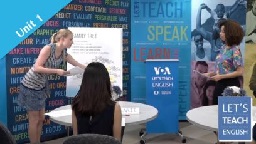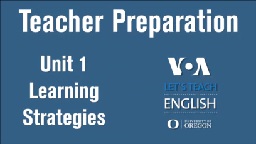|
|
| |
|
|
| |
|
|
|
|
| |
 Let's
Teach English Unit 1 Let's
Teach English Unit 1
The Let’s Teach English video series offers free online
training for English language educators worldwide. It is
based on the Women Teaching Women English text for
adult, beginning level learners. Voice of America and
the University of Oregon are partners on this project. |
|
|
|
Click to see the full PDF lesson -
opens in a new window. |
|
 Unit
1: Learning Strategies Unit
1: Learning Strategies
In this lesson, the teacher presents a learning
strategy. Before this class, the teacher introduced the
unit and the students practiced saying the new words and
wrote them on their family trees. |
Teacher Preparation Video
This episode shows a model of teaching learning strategies. |
|
 Video Transcript Video Transcript
Narrator: In this lesson, the teacher presents the learning strategy
summarize. We
join the class after the teacher has introduced the unit. Students have
practiced saying the new words and filled in their own family trees. |
|
|
Teacher: Good morning.
Students: Good morning.
Teacher: Who is ready to talk about your family?
Julia: I am ready.
Teacher: Great. Class, let's listen to Julia. Then I will summarize.
Jamie: What does that mean?
Teacher: First, I will listen to Julia. Then I will repeat her words in a
shorter way.
Summarizing helps you understand and remember better. Julia, tell us
something about each person in your family tree.
(Julia walks to the front of the class and puts sticky notes with names of
her family members on the poster of a family tree.)
Julia: There are three women in my house: my mother, Leah; my sister,
Stella,
and me, Julia. My sister is pregnant. She also has a son, Eric. I am his
aunt. My mother is his grandmother.
(Julia points to each name on the family tree as she describes each
person.)
Teacher: Thank you. Okay, Now to summarize.
Narrator: Modeling the strategy. Afterwards, the teacher models the
strategy,
summarize, by giving a summary of the student’s description. She
explains that summarizing helps in learning English.
Teacher: You have three women in your house. Your sister is pregnant and she
has
a son. You are an aunt. Your mother is a grandmother. Learning to
summarize is helpful for learning English. Let's stand up and make a line
by your birthdays.
Narrator: Pairing students at random. The teacher uses a technique to
randomly
assign partners. Students must talk with each other to line up in order.
This gives more variety to pair work and promotes active communication
between students.
Teacher: January at the front; December at the end.
(The teacher gestures to the front and end of the line at the front of the
room.)
(Students stand up and ask each other about their birthdays.)
Mimi: I'm January.
Julia: February.
Jamie: May.
Maryam: December.
Teacher: Okay, now bring the line around.
(Students walk to face each other.)
Teacher: The person across from you is your partner.
(The teacher gestures to one line.)
Teacher: This group – tell about your families.
(Teacher gestures to the other line.)
Teacher: This group - listen and take notes. Please have a seat.
Partners, listen carefully. I’ll ask you to summarize for your partner. Take
notes on your paper. Raise your hand when you're finished.
(The teacher models raising her hand.)
(Students sit in pairs and show their charts and talk about their family
members. One student in each pair is taking notes.)
Maryam: My brother is Vahab.
Mimi: Vahab is your brother.
Julia: Father, Peter. Mother, Eva. Right.
Mimi: Okay, I think we're done.
(Students raise hands to show their group's work is finished.)
Teacher: Now, hand the family tree to your partner. Listeners, look for
someone
who has no paper. Tell them about your partner’s family.
Narrator: Practicing the strategy. After the students talk in pairs, they
summarize
what they learned for a new partner. This creates a communicativesituation in which the student who is summarizing has information that the
listening student does not have.
Mimi: This is Maryam's family. She has a dad and a mom. And then she has a
brother, Vahab. And then her sister, Bahar.
Jamie: How old is she?
Mimi: She's six years older.
(Students discuss the others' family trees.)
Narrator: Summary: This activity gives each student time to work actively
with two
other students while practicing summarizing. Next time, join us for Unit 2.
We will teach listening skills and cooperative learning. |
|
Transcript Vocabulary
summarize (verb) – to tell (information) again using fewer words
© 2017 University of Oregon and Voice of America. This work is based on the
Women Teaching Women English materials
produced by the University of Oregon American English Institute under U.S.
Department of State Federal Assistance Award
S-LE200-10-GR-050, issued by the U.S. Embassy Beirut. |
|
|
|
|
|
|
|
|
|
|
|
|
Grammar Tips |
Can You Catch These Native Speaker Mistakes?
(Beginner - Listening)
An audio lesson to
help with your understanding of common mistakes. The English is
spoken at 75% of normal speed.
Click here to visit the lesson page with the written script for this
audio program. |
Commonly Confused Words: Part One
(Beginner - Listening,
reading)
A video lesson to
help with your understanding of commonly confused
words.
The English is
spoken at 75% of normal speed.
Click here to visit the lesson page. |
Commonly Confused Words: Part One
(Beginner - Listening)
An audio lesson to
help with your understanding of commonly confused
words. The English is
spoken at 75% of normal speed.
Click here to visit the lesson page with the written script for this
audio program. |
Commonly Confused Words: Part Two
(Beginner - Listening,
reading)
A video lesson to
help with your understanding of commonly confused
words.
The English is
spoken at 75% of normal speed.
Click here to visit the lesson page. |
Commonly Confused Words: Part Two
(Beginner - Listening)
An audio lesson to
help with your understanding of commonly confused
words. The English is
spoken at 75% of normal speed.
Click here to visit the lesson page with the written script for this
audio program. |
|
|
|
|
Search Fun Easy English |
|
|
|
|
|
|
|
|
|
|
|
|
|
|
|
About
Contact
Copyright
Resources
Site Map |